| Photo Gallery (34 Images) |
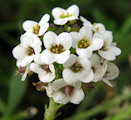 |
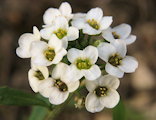 |
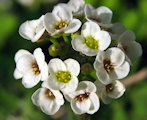 |
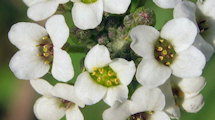 |
IMAGE: LBLMT-01 Photo of flower head, composed of many small (c. 4-5mm) white flowers. |
IMAGE: LBLMT-02 Each flower has 4 white petals arranged diagonally (or right angles) to each other - a characteristic of the Brassica (mustard) family. |
IMAGE: LBLMT-03 Each flowers has 6 stamens with yellow anthers and a central pistil ending with a swollen stigma. |
IMAGE: LBLMT-04 Close up photo of flowers. Stamens of mature flowers usually have purple-brown filaments (and style) while in very young flowers these are green. |
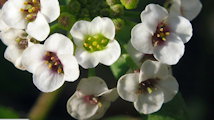 |
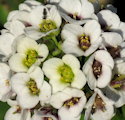 |
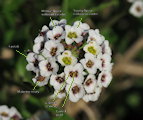 |
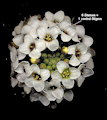 |
IMAGE: LBLMT-05 Close up photo of flowers, the youngest being that with a green centre. |
IMAGE: LBLMT-06 Close up photo of flowers. Many genera of the Brassicaceae family have species with 4 long stamens and 2 short ones, but Lobularia is an exception, because the stamens are similar. |
IMAGE: LBLMT-07 Annotated image of a flower cluster. |
IMAGE: LBLMT-08 Flower cluster against a dark background. |
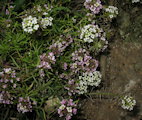 |
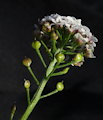 |
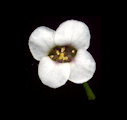 |
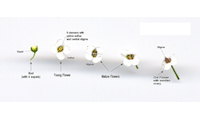 |
IMAGE: LBLMT-09 In rare cases, the plant with purple (or lilac) colour are seen in the wild. There is a cultivated variety of Lobularia maritima which has deep purple colours (see photo below). |
IMAGE: LBLMT-10 Lateral view of raceme with flowers at the top, and fruit gradually maturing down the stem. Fruiting pedicels become more distant from each other, unlike the clustered flowers. |
IMAGE: LBLMT-11 Scanned image of a single flower against a dark background. Although it seems that there are 7 yellow anthers, one of them is the style covered with yellow pollen. |
IMAGE: LBLMT-12 Scanned and annotated image of bud, young flowers and mature flowers. |
 |
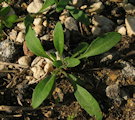 |
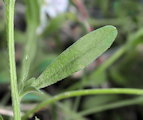 |
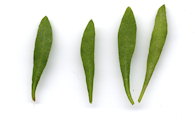 |
IMAGE: LBLMT-13 Scanned and annotated image of the flowering stem. |
IMAGE: LBLMT-14 Photo of a young plant showing several leaves which are between fusiform and oblanceolate in shape. |
IMAGE: LBLMT-15 Photo of a typical linear-lanceolate leaf of Lobularia maritima . They vary from narrow fusiform to sub-spathulate/lanceolate. Plant is often grayish due to short white hair. |
IMAGE: LBLMT-16 Scanned image of the fusiform (spindle-shaped) leaves. |
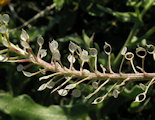 |
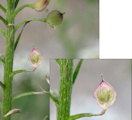 |
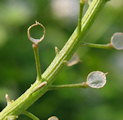 |
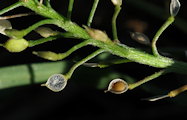 |
IMAGE: LBLMT-17 Photo of silicules one next to each other along stem. The translucent partition between the fruiting compartments remains for some time before it gets weathered away. |
IMAGE: LBLMT-18 Photo of mature fruit. It consists of a small, flattened pouch which holds one or two seeds. This fruiting structure is called a silicule and differs from a silique by having its length less than two times its width, (hence a rounded structure instead of an elongated one). |
IMAGE: LBLMT-19 Photo of an empty silicule. The central semi-translucent partition (sometimes called a replum) divides the 2 seeds that are attached with at either side. The replum remains for some days until it ruptures and leaves a hollowed circular structure. |
IMAGE: LBLMT-20 Photo of fruit (3mm in diameter) with one of the 2 seeds still attached to the translucent replum. |
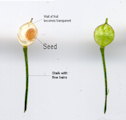 |
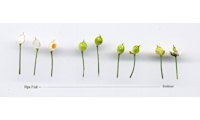 |
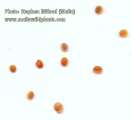 |
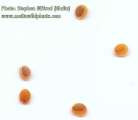 |
IMAGE: LBLMT-21 Scanned and annotated image of the silicule (=fruit). On maturation the outer green valves of the fruit falls away and exposes the seeds weakly attached to a translucent wall (=replum). |
IMAGE: LBLMT-22 Scanned image demonstrating the development of the fruit from the embryo stage to the formation of the ripe seeds. |
IMAGE: LBLMT-23 Scanned image of the orange-brown seeds. |
IMAGE: LBLMT-24 Magnified scanned image of seeds showing that they are enclosed in a semi-translucent chamber and are situated eccentrically inside. |
 |
 |
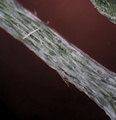 |
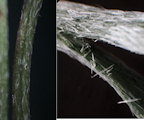 |
IMAGE: LBLMT-25 Magnified image of pollen under the light microscope. |
IMAGE: LBLMT-26 Magnified image of pollen under the light microscope. They are pitted and have an oval shape. |
IMAGE: LBLMT-27 Magnified image of white hair covering most parts of the plants, especially stems, pedicels and leaves. This pubescence gives the plant a certain grayish appearance. |
IMAGE: LBLMT-28 Magnified image of hair shows that is is not simple, but composed of 2 subulate parts (branches) split oppositely apart. |
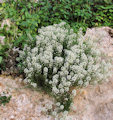 |
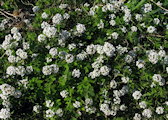 |
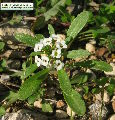 |
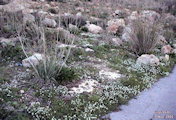 |
IMAGE: LBLMT-29 Photo of a beautiful specimen in mid November - peak of the flowering period for this perennial species which can be found in flowers throughout Autumn, Winter and Spring. |
IMAGE: LBLMT-30 Photo of plenty of flowers in situ. This low-growing plant looks attractive when it covers a patch of ground with numerous white flowers as seen in this photo. It blooming peak is November-February, but flowers can be seen almost all year round. |
IMAGE: LBLMT-31 Photo of a young plant showing its first inflorescence and several small leaves. |
IMAGE: LBLMT-32 Photo of plant taken at one of its preferred habitat, that is waysides with rocks or stones. |
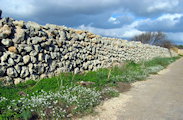 |
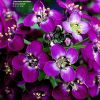 |
| |
IMAGE: LBLMT-33 Photo of plants taken at Dingli. This plant is commonly found lining pathways, stone walls and passages in the countryside. The plant is prominent between October to December when there is not much flowers or high foliage. |
IMAGE: LBLMT-34 Photo of a violet flower variant. (author and copyright of G.D. Carr). This and any other coloured flower forms are not found in Malta. |
IMAGE: LBLMT-35 - |
IMAGE: LBLMT-36 |

